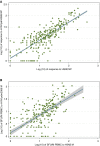Natural T Cell-mediated Protection against Seasonal and Pandemic Influenza. Results of the Flu Watch Cohort Study
- PMID: 25844934
- PMCID: PMC4476562
- DOI: 10.1164/rccm.201411-1988OC
Natural T Cell-mediated Protection against Seasonal and Pandemic Influenza. Results of the Flu Watch Cohort Study
Abstract
Rationale: A high proportion of influenza infections are asymptomatic. Animal and human challenge studies and observational studies suggest T cells protect against disease among those infected, but the impact of T-cell immunity at the population level is unknown.
Objectives: To investigate whether naturally preexisting T-cell responses targeting highly conserved internal influenza proteins could provide cross-protective immunity against pandemic and seasonal influenza.
Methods: We quantified influenza A(H3N2) virus-specific T cells in a population cohort during seasonal and pandemic periods between 2006 and 2010. Follow-up included paired serology, symptom reporting, and polymerase chain reaction (PCR) investigation of symptomatic cases.
Measurements and main results: A total of 1,414 unvaccinated individuals had baseline T-cell measurements (1,703 participant observation sets). T-cell responses to A(H3N2) virus nucleoprotein (NP) dominated and strongly cross-reacted with A(H1N1)pdm09 NP (P < 0.001) in participants lacking antibody to A(H1N1)pdm09. Comparison of paired preseason and post-season sera (1,431 sets) showed 205 (14%) had evidence of infection based on fourfold influenza antibody titer rises. The presence of NP-specific T cells before exposure to virus correlated with less symptomatic, PCR-positive influenza A (overall adjusted odds ratio, 0.27; 95% confidence interval, 0.11-0.68; P = 0.005, during pandemic [P = 0.047] and seasonal [P = 0.049] periods). Protection was independent of baseline antibodies. Influenza-specific T-cell responses were detected in 43%, indicating a substantial population impact.
Conclusions: Naturally occurring cross-protective T-cell immunity protects against symptomatic PCR-confirmed disease in those with evidence of infection and helps to explain why many infections do not cause symptoms. Vaccines stimulating T cells may provide important cross-protective immunity.
Keywords: T lymphocytes; cellular immunity; cohort studies.
Figures



References
-
- Carrat F, Vergu E, Ferguson NM, Lemaitre M, Cauchemez S, Leach S, Valleron AJ. Time lines of infection and disease in human influenza: a review of volunteer challenge studies. Am J Epidemiol. 2008;167:775–785. - PubMed
-
- Wang TE, Lin CY, King CC, Lee WC. Estimating pathogen-specific asymptomatic ratios. Epidemiology. 2010;21:726–728. - PubMed
-
- Noble GR. Epidemiological and clinical aspects of influenza. In: Beare AS, editor. Basic and applied influenza research. Boca Raton, FL: CRC Press; 1982. pp. 11–50.
MeSH terms
Grants and funding
LinkOut - more resources
Full Text Sources
Other Literature Sources
Medical
Miscellaneous

